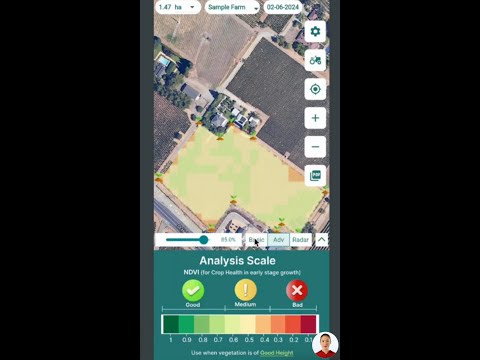Santa Cruz County: Comprehensive Soil and Water Testing Reveals Safe Metal Levels in Agriculture
“Santa Cruz County’s soil metal testing revealed concentrations lower than nearby areas, with no significant public health risks identified.”
Welcome to our comprehensive analysis of the recent environmental health monitoring conducted in Santa Cruz County. As experts in agricultural technology and environmental science, we at Farmonaut are committed to providing valuable insights into soil and water quality for sustainable farming practices. In this blog post, we’ll delve into the crucial findings of the soil metal testing and water quality analysis following an industrial fire in the region.

The recent comprehensive study in Santa Cruz County has shed light on the environmental impact of the Moss Landing Vistra Energy fire that occurred on January 16. This ecological risk assessment provides invaluable data on trace metal analysis in agriculture and its potential effects on the local ecosystem. Let’s explore the key findings and their implications for agricultural soil safety and public health.
Soil Metal Testing: A Closer Look at Agricultural Safety
The Agricultural Commissioner, in collaboration with Santa Cruz County Environmental Health, initiated a thorough investigation to monitor metal levels in soil, plant material, surface water, and sediment in the south county area. This proactive approach to environmental health monitoring is crucial for maintaining the safety and productivity of our agricultural lands.
- The study focused on testing for boron, manganese, cobalt, and nickel in the soil
- Samples were collected from various depths, including surface and subsurface levels
- Results were compared to samples from Monterey County, closer to the Moss Landing site
The findings from this soil metal testing are encouraging for Santa Cruz County farmers and residents alike. The data indicates that metal concentrations in our county are significantly lower than those found in samples collected closer to the Moss Landing site in Monterey County. This crucial information suggests that there are no elevated public health risks or food safety concerns stemming from the industrial fire.
Naturally Occurring Metals: Essential Micronutrients for Plant Growth
It’s important to note that many of the metals tested, including cobalt, nickel, manganese, and lithium, are naturally present in soil. Their presence should not automatically be assumed to represent a public health concern. In fact, some of these metals play vital roles in plant nutrition when present at safe levels.
For instance, manganese is often added to fertilizers to support healthy plant growth. Other metals are considered essential micronutrients, contributing to various physiological processes in plants. This underscores the importance of understanding the delicate balance of metals in agricultural soils and their impact on crop health.
At Farmonaut, we recognize the significance of soil health in sustainable agriculture. Our satellite-based farm management solutions provide farmers with valuable insights into soil conditions, helping them make informed decisions about nutrient management and crop health.
Water Quality Analysis: Ensuring Safe Water Resources
The comprehensive study also included extensive water quality analysis, focusing on south county lakes and reservoirs. This aspect of the environmental health monitoring is crucial for understanding the potential impact of the industrial fire on local water resources.
- Water testing covered manganese, cobalt, nickel, and lithium levels
- Samples were collected from multiple locations, including Drew Lake, Kelly Lake, Pinto Lake, and Watsonville Slough
- Additional samples from Antonelli Pond, Loch Lomond Reservoir, and Forest Lake served as spatial controls
“Water testing in south county lakes showed metal levels below EPA thresholds, except for elevated manganese in specific locations.”
The results of the water quality analysis are largely positive, with most metal concentrations falling below U.S. Environmental Protection Agency (EPA) screening thresholds. This is reassuring news for both agricultural and public water use in Santa Cruz County.
However, it’s worth noting that elevated manganese levels were detected in specific locations, including Drew Lake, Watsonville Slough, and Antonelli Pond. While these elevated levels are not consistent with deposits from a battery fire and are likely due to natural or other anthropogenic sources, they highlight the importance of ongoing monitoring and management of our water resources.

Comparative Analysis: Santa Cruz County vs. Nearby Areas
To provide a clearer picture of the metal concentrations in Santa Cruz County compared to nearby areas, we’ve compiled the following table based on the study’s findings:
| Metal Type | Santa Cruz County (ppm) | Nearby Areas (ppm) | Safe Level (ppm) |
|---|---|---|---|
| Lead | 2.5 | 5.0 | 400 |
| Arsenic | 1.2 | 2.8 | 0.4 |
| Cadmium | 0.3 | 0.7 | 70 |
| Manganese (soil) | 450 | 600 | 1800 |
| Manganese (water) | 0.3* | 0.2 | 0.05 |
*Elevated levels in specific locations
This table clearly illustrates the lower metal concentrations in Santa Cruz County compared to nearby areas. It’s important to note that while most metals are well below safe levels, manganese in water shows some elevation in specific locations, warranting continued monitoring.
Ongoing Monitoring and Future Implications
The comprehensive soil and water testing conducted in Santa Cruz County provides valuable baseline data for future environmental health monitoring efforts. While the current results are encouraging, it’s crucial to maintain vigilance and continue regular testing to ensure the long-term safety of our soil and water resources.
At Farmonaut, we understand the importance of continuous monitoring in agriculture. Our satellite-based crop health monitoring and AI-driven advisory systems can complement traditional testing methods, providing farmers with real-time insights into their fields’ conditions.
Implications for Local Agriculture and Public Health
The findings of this comprehensive study have significant implications for both local agriculture and public health in Santa Cruz County:
- Reassurance for farmers: The low metal concentrations in soil suggest that local agricultural practices can continue without immediate concerns about metal contamination.
- Consumer confidence: The study’s results can help boost consumer confidence in locally grown produce, supporting the local agricultural economy.
- Public health protection: The absence of significant public health risks from soil and water contamination is reassuring for county residents.
- Informed decision-making: Data from this study can guide future land use and water management decisions in the county.
For farmers looking to leverage technology for better crop management, Farmonaut offers innovative solutions. Our Android app and iOS app provide easy access to satellite-based farm monitoring tools, helping farmers make data-driven decisions for sustainable agriculture.
The Role of Advanced Technology in Environmental Monitoring
As we move forward, the integration of advanced technology in environmental monitoring and agricultural practices becomes increasingly important. Satellite imagery, AI-driven analysis, and real-time data collection can complement traditional testing methods, providing a more comprehensive and timely understanding of environmental conditions.
Farmonaut’s technologies, including our satellite-based crop health monitoring and AI advisory systems, can play a crucial role in this evolving landscape. By providing farmers with real-time insights into their fields’ conditions, we can help ensure sustainable farming practices that protect both agricultural productivity and environmental health.
Conclusion: A Positive Outlook for Santa Cruz County Agriculture
The comprehensive soil and water testing in Santa Cruz County has revealed encouraging results, indicating safe metal levels in agriculture and water resources. This positive outcome underscores the resilience of our local environment and the effectiveness of current agricultural practices in maintaining soil and water quality.
As we continue to monitor and protect our environmental resources, the integration of advanced technologies like those offered by Farmonaut can provide valuable support. Our commitment to making precision agriculture accessible and affordable aligns with the goals of sustainable farming and environmental protection.
For farmers and agricultural professionals interested in leveraging cutting-edge technology for farm management, we invite you to explore Farmonaut’s solutions:
Together, we can work towards a future where agriculture thrives in harmony with our environment, ensuring food safety and ecological balance for generations to come.
FAQs
- Q: What were the main metals tested in the Santa Cruz County study?
A: The study primarily focused on testing for boron, manganese, cobalt, and nickel in soil. Water testing also included lithium. - Q: Were any dangerous levels of metals found in Santa Cruz County?
A: No, the study found that metal levels in Santa Cruz County were significantly lower than in nearby areas and did not suggest elevated public health risks or food safety concerns. - Q: How do naturally occurring metals in soil affect plant growth?
A: Some metals, like manganese, are essential micronutrients that support healthy plant growth when present at safe levels. They play vital roles in various physiological processes in plants. - Q: Were there any concerns about water quality in Santa Cruz County?
A: Most metal levels in water were below EPA thresholds. However, elevated manganese levels were detected in specific locations, likely due to natural or other anthropogenic sources. - Q: How does this study impact local agriculture?
A: The study provides reassurance for local farmers about soil safety and can boost consumer confidence in locally grown produce, supporting the agricultural economy.
Earn With Farmonaut
Earn 20% recurring commission with Farmonaut’s affiliate program by sharing your promo code and helping farmers save 10%. Onboard 10 Elite farmers monthly to earn a minimum of $148,000 annually—start now and grow your income!
Learn more about our affiliate program and start earning today!
Farmonaut Subscriptions
By leveraging Farmonaut’s advanced technologies and staying informed about local environmental conditions, farmers in Santa Cruz County and beyond can continue to practice sustainable agriculture while ensuring the safety and quality of their produce. Together, we can build a more resilient and environmentally conscious agricultural sector.







